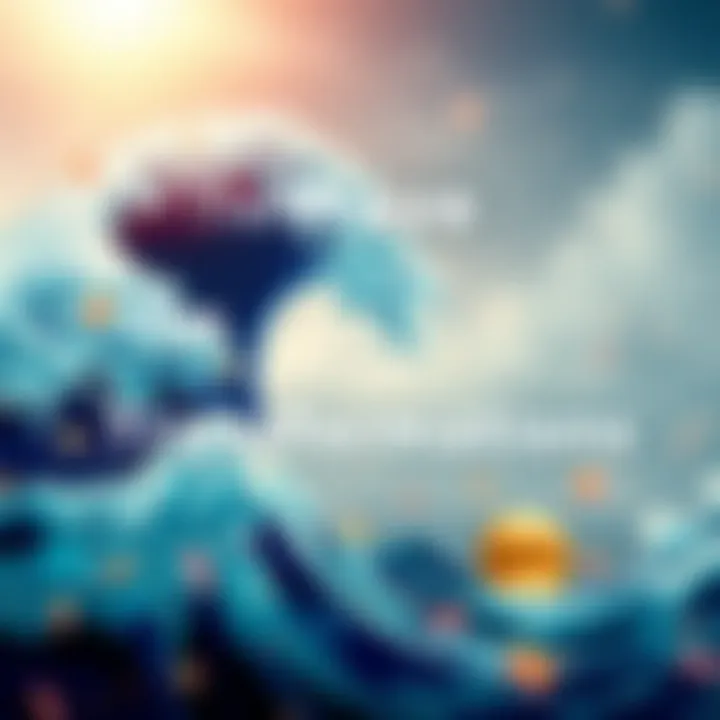Essential Reads: Key Literary Works Shaping Culture


Intro
In the landscape of literature, periods of seismic shifts—often referred to as "booms"—can redefine genres and set the stage for new cultural dialogues. Over time, certain books have emerged not only as popular reads but as catalysts for change, influencing both individual perspectives and societal norms. This article seeks to delve into such transformative works, showcasing their significance and exploring how they have shaped literary traditions as well as broader cultural contexts. By engaging with these standout texts, readers can embark on a journey of intellectual growth and personal reflection.
Categories of Life-Changing Books
Exploring life-changing literature often falls into two prominent categories: self-help and personal development, and fiction that carries transformative themes. Each category offers unique insights and experiences, guiding readers through both self-discovery and profound emotional journeys.
Self-Help and Personal Development
Among the many self-help books, titles like Thinking, Fast and Slow by Daniel Kahneman stand at the forefront. This book offers enlightening perspectives on how our minds work, dissecting the dichotomy between instinct and reasoning. Kahneman’s exploration of cognitive biases serves as a tool for readers to navigate their decision-making processes, drawing them closer to enlightenment about their own thought patterns.
Another notable title is The Power of Habit by Charles Duhigg. Duhigg presents a compelling narrative on habit formation through scientific research and relatable anecdotes, offering both an engaging read and practical strategies for change. By understanding how habits work, readers can build better routines that lead to fulfilling lives.
Fiction with Transformative Themes
Fiction also plays a vital role in shaping perspectives. For instance, George Orwell's 1984 provokes critical thought about authority, privacy, and individuality in a dystopian world. Through its chilling portrayal of a totalitarian regime, Orwell's work ignites discussions surrounding freedom and oppression, touching the core of personal sovereignty.
Similarly, The Alchemist by Paulo Coelho, while simple in prose, weaves a profound tapestry of personal legend and destiny. Readers are invited on a quest of self-actualization and dreams, prompting a reevaluation of their own life’s purpose.
Book Summaries and Insights
Each text comes with its unique lessons, resonating far beyond the pages. Engaging with these books on a deeper level can yield insights that are not merely theoretical but highly applicable in daily life.
Key Takeaways from Popular Titles
- Thinking, Fast and Slow: Highlights the importance of awareness of cognitive biases; encourages critical thinking.
- The Power of Habit: Offers practical steps to transform daily habits; emphasizes the science behind change.
- 1984: Serves as a cautionary tale about unchecked authority and individual freedoms; inspires activism and vigilance.
- The Alchemist: Emphasizes the value of pursuing one's dreams and listening to one's heart, nurturing inner confidence.
How to Apply Insights in Daily Life
To truly benefit from these literary gems, readers can start weaving their insights into everyday practices. One approach could be setting specific goals inspired by the teachings from The Alchemist, while simultaneously questioning daily decisions as suggested by Kahneman’s work.
Regular reflection on habits can help in filtering those that serve one's aspirations. Journaling or discussing these insights in study groups further solidifies understanding.
"Books are a uniquely portable magic." — Stephen King
By exploring these essential reads, each individual opens the door to greater understanding—not only of literature but of life itself. The interplay of narrative and lesson creates a rich tapestry of knowledge that engages the intellect and stirs the soul.
For those who wish to explore further, Wikipedia offers additional information on the influences of major literary movements here. Likewise, the insights offered on Reddit’s literature communities can spark engaging discussions here. Additionally, educational resources from institutions can be explored for a more scholarly perspective here.
Understanding Literary Booms
Literary booms mark transformative phases in the world of writing. This section digs into the fundamental elements of these booms, shedding light on their significance and influence in the literary landscape. It’s imperative to grasp how literature evolves through these periods, as they shape not just stories but the way we understand culture and society at large.
Definition of a Literary Boom
A literary boom can be understood as a burst of activity within a specific genre or movement, during which a notable increase in publications occurs. It is characterized by the emergence of influential works that often challenge existing norms and introduce fresh perspectives. These bursts are not merely about quantity; they signify a qualitative leap in literary output, bringing forth texts that resonate with the zeitgeist. The term does not refer to just popularity; rather, it addresses the core impact of literature on ideas and values.
Historical Context of Booms
To appreciate the significance of literary booms, one must consider their historical contexts. For instance, the Modernist Boom in the early 20th century arose from disillusionment post-World War I, prompting writers like F. Scott Fitzgerald and James Joyce to explore fragmented narratives and deep psychological insight. Similarly, the Self-Help genre began gaining traction in the late 20th century, reflecting societal shifts towards personal empowerment. Each boom arises from specific cultural, social, or political climates, highlighting literature's role in mirroring and responding to its environment.
Characteristics of Significant Works
Significant works that emerge during these booms often share certain characteristics. Here are some notable traits:
- Innovative Narratives: These texts frequently break traditional narrative forms, experimenting with structure and style.
- Thematic Depth: They delve into complex themes like identity, society's ethics, and human nature, pushing boundaries.
- Cultural Relevance: Works from these periods resonate with the experiences and struggles of their times, making them relatable and impactful.
- Critical Acclaim: Often, they receive substantial recognition from critics and readers alike, solidifying their place in literary history.
"The best literary booms are those that not only entertain but also provoke thought and discussion."
By delving deeper into the complex world of literary booms, readers can appreciate how these transformative moments not only shape the canon of literature but also reflect and influence society at large.
Examining Key Examples of Literary Booms
When discussing literary booms, examining key examples serves as a window into understanding how certain works can define or altogether reshape genres. These works not only reflect the zeitgeist of their time but also set the stage for future writers. By dissecting notable examples, we can appreciate the intricate tapestry of influence that these books weave across literature and culture. Within this section, we will delve into three significant booms: the Modernist Boom, the Postmodern Boom, and the rise of self-help literature. Each of these categories showcases the diverse voices and revolutionary ideas that contribute to their lasting impact.


The Modernist Boom
Modernism pushed against the boundaries of traditional narrative structures, diving deep into the human psyche while experimenting with form and style. The works from this boom, often marked by a newfound sense of disillusionment post-World War I, are foundational to understanding contemporary literature.
The Great Gatsby
F. Scott Fitzgerald's The Great Gatsby exemplifies the Jazz Age's pulse and the bewildering intersections of wealth and disillusionment. This novel captures the euphoria and decay of the American Dream. One standout characteristic is its intricate narrative style, which blends both lyrical prose and sharp social commentary. The depth of Gatsby as a character helps readers explore the contrasts between illusion and reality, capturing the essence of hope amidst despair.
While The Great Gatsby remains a popular choice for literary studies, the unique feature of its symbolic use of colors and the green light makes it a rich text for analysis. However, some might argue its brevity leaves too many threads unresolved, inviting endless interpretations.
Ulysses
James Joyce's Ulysses stands as a hallmark of innovation in literature. This epic novel, set during a single day in Dublin, deftly mirrors Homer’s Odyssey. It challenges traditional narrative forms through the use of stream of consciousness and intricate structures. Its remarkable attention to detail allows for an immersive experience into the ordinary lives of its characters.
Many readers find Ulysses to be both daunting and rewarding. Its complexity can be a double-edged sword—enticing ardent readers while deterring casual ones. Still, its contribution to modern narrative techniques cannot be overstated, making it a staple in any literary exploration.
To the Lighthouse
Virginia Woolf’s To the Lighthouse represents a significant departure from straightforward storytelling, instead focusing on the inner thoughts of its characters. The unique feature of its non-linear timeline draws readers into the spontaneity of human experience, emphasizing perception over plot.
Woolf’s exploration of time and memory, set against the backdrop of a seaside house, creates a hauntingly beautiful narrative. This book serves as a vital piece of modernist literature because its psychological depth invites introspection and a deeper understanding of the characters’ lives. For some, this may feel disjointed, but for others, it embodies emotional authenticity.
The Postmodern Boom
Postmodernism, often marked by irony and skepticism toward grand narratives, invited readers to grapple with themes of fragmented identity and reality. This boom produced texts that challenge the conventions of storytelling, creating a dialogue around the purpose and function of literature itself.
Gravity's Rainbow
Thomas Pynchon’s Gravity's Rainbow is a labyrinthine masterpiece that pushes the boundaries of narrative. The novel intertwines historical events with conspiracy theories, presenting a tapestry of interconnected stories. Its disjointedness forces readers to actively engage, piecing together meaning from chaos.
One distinguishing feature of this work is its vast array of references across various fields, including science and philosophy. While these elements make the book richly rewarding for those willing to invest the time, they may alienate readers looking for a more linear experience.
White Noise
Don DeLillo’s White Noise offers a satirical lens on consumerism and the saturation of media in daily life. DeLillo’s trademark wit and ability to blend the profoundly philosophical with the mundane produce a narrative that’s both entertaining and thought-provoking. The book stands out for its commentary on the noise of modern life, encapsulating the anxieties of the time.
Many regard White Noise as a critical assessment of contemporary society; however, its abrupt shifts in tone and style can sometimes leave readers questioning its core message.
Beloved
Toni Morrison’s Beloved serves not just as a narrative about reclaiming history, but as a powerful statement about the legacies of slavery in America. Centered on the haunting tale of a mother and her children, the novel delves deeply into themes of memory and trauma. One key characteristic lies in its lyrical prose, which carries both the beauty and the brutality of its subject matter.
The unique narrative structure intertwines spectral elements with gritty realism, offering an emotionally charged reading experience. However, this same complexity can be challenging for some readers, requiring a commitment to navigate its emotional landscape.
The Self-Help Genre as a Boom
While different from the literary booms noted above, the rise of the self-help genre has been equally transformative. This boom addresses personal development and seeks to offer actionable insights for better living, catering to a diverse audience.
The Habits of Highly Effective People
Stephen Covey’s The 7 Habits of Highly Effective People remains a foundational text in the self-help category. By outlining key habits that align personal and professional success, it offers practical steps for individuals seeking to foster growth. The key characteristic of this work is its structured approach, which simplifies complex ideas into digestible concepts.
Covey's insights promote reflective practices that invite readers to engage in self-assessment. While the book is widely regarded as beneficial, some critics argue that its principles can feel overly prescriptive in a world that values individual approaches.
How to Win Friends and Influence People
Dale Carnegie's How to Win Friends and Influence People has become a classic in interpersonal relationship-building. The text emphasizes the importance of understanding others' perspectives to foster collaboration and rapport. Its approachable style makes it an enduring read for a wide audience.
Carnegie’s focus on empathy and genuine communication distinguishes his approach. Although the principles can sometimes seem simplistic, the core message that meaningful relationships can be cultivated brings timeless relevance to the work.
Atomic Habits
James Clear’s Atomic Habits explores the compounding effects of small changes in behavior. This modern self-help book introduces readers to the idea that transforming habits into positive actions can lead to profound shifts over time. It’s accessible, practical, and engages readers with its straightforward advice.
One unique feature of Atomic Habits is its framework on identity change; Clear posits that to change behavior effectively, individuals must first alter their self-perception. While many find its advice practical and easy to apply, some may feel it lacks the depth of more philosophical self-help works.
"Literary booms present an opportunity for readers to engage with texts that can influence their views on society, identity, and personal growth."


In summation, the examples drawn from these booms illustrate literature's role not just as a mirror of culture but as a catalyst for transformation. By examining these key texts, we uncover insights that resonate through time, enrich our understanding of human experiences, and invite us to engage with the pressing questions of our own lives.
The Cultural Impact of Booms
The literary landscape is akin to a vibrant tapestry, woven together by various threads of cultural narratives that drive society forward. The impact of literary booms transcends mere entertainment; they are pivotal in shaping social dynamics, ideologies, and even everyday interactions. In this section, we will explore the significant ways in which these booms influence culture, molding the values we hold and the conversations we engage in.
Shaping Social Norms and Values
Literary booms often emerge during periods of great social change, acting as mirrors reflecting the zeitgeist of their times. They expose readers to fresh perspectives, challenging entrenched beliefs and inspiring shifts in thought. For instance, consider the feminist literature boom of the late 20th century. Works like The Handmaid's Tale by Margaret Atwood do more than tell a story; they ignite discussions surrounding women's rights, equality, and autonomy, leading to profound societal shifts.
When these narratives resonate, they often seep into the fabric of cultural norms. Books can incite movements, shaping how we view everything from gender roles to economic classes. The themes explored in a boom not only validate the experiences of marginalized groups but also encourage the broader population to reconsider their views.
Influencing Other Media
The reach of literary booms extends well beyond the pages of books. When a book captures the public's imagination, it's common for it to leap into other media formats. Adaptations into films, television series, and even podcasts allow the stories to proliferate, reaching audiences who might not typically turn to reading. Consider how The Great Gatsby has been adapted innumerable times, each retelling reinforcing or reframing its commentary on identity and aspiration across generations.
Moreover, the themes and styles prevalent in boom literature can inspire creators across various disciplines. Graphic novels, visual art, and even music may find their roots in these literary trends. They serve as a cultural reservoir, whereby the ideas within can flow into different artistic expressions, thus enriching the cultural landscape.
Fostering Dialogue and Debate
Literary booms generate a wealth of material for discussion, equipping readers with issues that demand attention and thoughtful debate. The controversial nature of some works often spurs varying interpretations, allowing for robust dialogue on platforms ranging from book clubs to social media. For instance, books like Beloved by Toni Morrison provoke discussions around race, trauma, and memory, ultimately fostering deeper understandings of historical contexts and contemporary implications.
These dialogues can take many forms, from casual conversations among friends to full-blown academic debates. The nuances within each piece challenge readers to engage critically with content, encouraging them to articulate their thoughts and understand contrasting viewpoints.
Furthermore, such discourse often reaches beyond literature, influencing political movements and social initiatives. Take for example the conversation around climate change catalyzed by works like This Changes Everything by Naomi Klein. The discourse initiated by this boom in environmental literature not only elevates awareness but also calls for action, impacting policy discussions and community initiatives.
"Literature is the most agreeable way of ignoring life." - Fernando Pessoa
Boos and Trends in Contemporary Literature
In the intricate tapestry of literature, contemporary booms illuminate societal shifts and evolving narratives. Understanding these trends is crucial for anyone invested in literature today, whether students, professionals, or avid readers. These booms not only reflect the themes and issues defining our times but also shape how literature is produced and consumed. The significance of examining these trends lies in the ability to appreciate how literature not only tells stories but also influences thought, culture, and identity.
The Rise of Diverse Voices
In recent years, there's been a noticeable elevation of diverse voices in literature. Authors from various backgrounds are stepping into the spotlight, sharing stories that resonate across different cultures and experiences. This trend is essential because it challenges the traditional narratives often presented in mainstream literature.
For example, consider the works of authors like Chimamanda Ngozi Adichie, whose book Americanah captures the complexities of identity and race in contemporary society. Such narratives are not just stories; they are powerful perspectives that help readers gain a deeper understanding of the world around them.
The rise of these voices does more than just diversify the literary landscape; it encourages empathy and a broader comprehension of human experiences. This shift presents a richer tapestry of views that directly responds to a globalized world where cross-cultural understanding is vital.
Exploration of Identity and Experience
Another noticeable trend in contemporary literature is the exploration of identity and personal experience. With the landscape of identity becoming more complex, literature has evolved accordingly to reflect these nuances. The conversation around identity today encapsulates aspects of race, gender, sexuality, and class, making each narrative uniquely personal yet universally relevant.
Books like The Hate U Give by Angie Thomas explore profound themes of race and identity through the eyes of a young black girl facing the realities of racial inequality. This kind of storytelling allows readers to engage with lived experiences that may be outside their own, fostering a deeper understanding and connection to diverse narratives.
Furthermore, these explorations often present a challenge to societal norms and provoke critical debates. They urge readers to reflect on their own identities and the roles they play within their communities, which is essential for fostering dialogue among varied audiences.
The Shift Towards Digital Literature
In our increasingly digitized world, the trend toward digital literature cannot be overlooked. With the advent of e-books and online platforms, authors now have a myriad of channels to share their work. This shift is shaping readers' habits and expectations, offering them accessibility and convenience that traditional formats may not always provide.
Digital literature includes not just e-books, but also serialized storytelling, podcasts, and interactive narratives. These forms engage readers in new and creative ways, allowing for a more immersive experience. For instance, websites like Wattpad enable aspiring authors to share their stories with an audience, democratizing the literary process like never before.
This transition doesn't just impact how literature is consumed; it changes what literature can be. New mediums allow for innovative storytelling methods that can break the fourth wall or even incorporate multimedia elements, providing an experience that is both diverse and dynamic.
As we look to the future, understanding these contemporary booms and trends is essential, not only for appreciating where literature has been but also for anticipating where it’s headed. The intersection of diverse voices, identity exploration, and digital formats may very well redefine the literary landscape in profound ways.
Navigating Must-Read Lists
In the vast ocean of literature, must-read lists serve as compasses guiding literature enthusiasts through an often overwhelming array of choices. Navigating these lists is not merely about picking up the latest bestseller or flipping through popular recommendations; it's about honing in on what resonates with individual tastes and intellectual curiosities. In this section, we will uncover the significance of personalized reading paths, the subtleties of evaluating suggestion quality, and effective strategies to keep up with recent literary imports.
Curating Personalized Reading Lists
Creating a personalized reading list is akin to assembling a bespoke wardrobe. Each book should reflect unique preferences, interests, and life experiences, contributing to a richer reading experience. To achieve this, one could start by reflecting on prior favorites—defining elements like themes, genres, or writing styles that held particular appeal.


Utilizing platforms such as Goodreads or library systems can help in this endeavor. These tools can not only track reading history but also suggest titles based on past selections. Furthermore, engaging with book clubs or online communities fosters exposure to diverse perspectives, often steering individuals toward titles they might not have considered otherwise.
Evaluating the Quality of Recommendations
When it comes to literary recommendations, not all suggestions are created equal. To sift through noise, it's vital to consider the source of the recommendations. Are they from reputable literary critics, personal friends whose taste aligns with yours, or algorithms that function solely on data? Each source carries a different weight.
A more discerning approach includes looking at reviews and ratings from varied platforms, noting if they highlight aspects that resonate with one's literary preferences. Additionally, checking the backgrounds of the authors of recommended books can provide insight. Books often reflect the author's experiences and viewpoints. Recognizing this can help gauge if a book aligns well with personal tastes, which fosters a more meaningful reading journey.
Staying Updated with New Releases
In today’s fast-paced literary world, being in the know about new releases can feel like chasing shadows. Yet, it's crucial for those seeking to be at the forefront of literary trends and discussions.
Subscribing to literary newsletters, following notable publishers and authors on social channels, or engaging with book vlogs are excellent strategies. For more structured updates, one might consider services like Book Riot or even library platforms that announce new arrivals tailored to user preferences. Innovative apps that push alerts for upcoming releases based on past reads can be game-changers.
Engaging proactively not only nourishes your own intellectual curiosity but also cultivates a sense of community among fellow readers.
Engaging with the Text
Engaging with the text is a cornerstone in the realm of literature, particularly when navigating through the myriad of booms that have shaped our cultural landscape. It is not just about reading words on a page; rather, it's an immersive experience that allows individuals to grasp the nuances, themes, and motivations behind the written word. True engagement transforms a passive reading session into an insightful exploration. This active interaction with literature fosters deeper understanding and critical thought, leading to personal growth and intellectual enrichment.
In this age of information overload, where distractions abound, the ability to focus on and engage with a text is invaluable. Rather than skimming through paragraphs, absorbing content at a deeper level increases one's appreciation of literary craftsmanship. Engaging comprehensively with a work can also contextualize it within the broader spectrum of its genre and era, shedding light on how specific literary booms emerged and influenced society.
Beyond immediate comprehension, engaging actively includes questioning the text. Readers can ask: What is the author attempting to convey? What cultural or historical influences are at play? Such inquiries lead to richer discussions, both internally and with others.
Active Reading Techniques
Active reading techniques are strategies that enable readers to interact with the text more meaningfully. Here are a few to consider:
- Preview the Material: Before delving into a novel or essay, skim the introduction and conclusion. This initial glance can illuminate the main points and provide a framework for what’s to come.
- Highlight Key Passages: Use a highlighter or digital tool to mark passages that resonate with you. This creates a visual roadmap of important themes and ideas.
- Ask Questions: Formulate questions that arise while reading. Write them down to explore later; this practice fosters curiosity.
- Summarize Sections: After finishing a chapter or significant portion, pause to summarize what you've just learned. This technique solidifies comprehension and transforms reading into an active pursuit.
Taking Notes and Summaries
Taking notes is akin to having a conversation with the text—an exchange that involves synthesizing thoughts and reactions. Here's how to effectively jot down notes and summaries:
- Use Marginalia: Write comments or reflections in the margins of the book. This technique creates an immediate record of your thoughts and feelings as they arise.
- Create Structured Summaries: After reading a chapter, write a brief summary that encapsulates the main ideas. Use bullet points for clarity. This process helps distill complex information into digestible insights.
- Incorporate Personal Reflections: When summarizing, consider what the text means to you personally. This connection deepens your understanding and appreciation of the material.
- Leverage Technology: Consider using note-taking apps, like Evernote or Notion, which can organize your thoughts and allow easy access later.
Discussing Insights with Others
One of the most rewarding aspects of engaging with literature is discussing insights with others. Conversations about a book can expose new interpretations and perspectives. Here’s how to make the most of these discussions:
- Join a Book Club: Being part of a community of readers fosters a space for dialogue. Book clubs often encourage members to share varied interpretations and insights, enriching the overall experience.
- Utilize Online Forums: Websites like Reddit have countless threads centered on specific texts, where discussions can flourish beyond geographic boundaries.
- Engage in Reflective Discussions: When discussing a book with friends, bring forward your insights but be open to others’ viewpoints. This respectful exchange can lead to deeper realizations about the text.
- Write Reviews or Blogs: Taking your thoughts public, through reviews or personal blogs, can further clarify your understandings and engage strangers into your narrative.
Engaging with literature is a rewarding pursuit, and applying these practices can illuminate the path toward greater understanding of both texts themselves and the boom periods that produced them. Through active reading, note-taking, and discussion, readers can unlock a treasure trove of insights that might otherwise remain hidden.
The Future of Literary Booms
The landscape of literature continues to evolve, making the exploration of the future of literary booms not just timely but crucial for anyone invested in the realm of books. Understanding where literature is heading helps to anticipate shifts in cultural conversations, intellectual movements, and even market dynamics. As new voices and perspectives emerge, it becomes essential to recognize the trends that spark excitement among readers and shape genres.
Emerging Trends to Watch
Several key trends are beginning to take root in the literary sector. These trends reflect not only changing tastes among readers but also broader societal movements. Here are a few worth noting:
- Diversity and Inclusion: The push for diverse narratives is stronger than ever. Readers are clamoring for stories that reflect a variety of cultures, experiences, and backgrounds, helping to break down old barriers.
- The Blending of Genres: Authors are increasingly mixing genres, creating hybrids that challenge traditional literary categorization. For instance, works that skillfully combine sci-fi elements with historical fiction are gaining traction, expanding how readers perceive stories.
- Interactive Storytelling: Choose-your-own-adventure narratives and multimedia experiences are on the rise. This trend serves not only to engage readers but also to transform how stories can be told and consumed.
By keeping an eye on these emerging trends, readers and writers alike can stay ahead of the curve and prepare for the necessary adaptations in literary consumption and production.
Potential Impact on Readers
The future of literary booms holds significant implications for readers. As the literary world shifts, so too do the dynamics of how stories are consumed and valued. Here’s how:
- Broader Perspectives: Exposure to diverse authors and stories allows readers to grasp a fuller understanding of humanity and the world, fostering empathy and cultural awareness.
- Enhanced Engagement: Interactive narratives can lead to greater involvement from readers, making the act of reading more participatory than ever before.
- Critical Thinking Skills: The blending of genres encourages readers to think critically about literature, forcing them to confront and question traditional narrative structures and themes.
As such, being attuned to how these trends impact reading habits and preferences will prepare readers for a richer, more complex literary experience.
How Technology is Shaping Literature
Technology plays a pivotal role in shaping the future of literature, influencing how stories are created, shared, and read. Some notable impacts include:
- Digital Publishing: E-books and self-publishing platforms have democratized literature, allowing a wider array of voices to be heard. Small-press authors and self-published writers can publish their works without the backing of traditional publishers.
- Social Media Impact: Platforms such as Twitter and Facebook have transformed book marketing, giving rise to phenomena like the BookTok community, where recommendations and reviews can go viral in a matter of hours. This changes how books gain visibility and popularity.
- AI in Writing and Editing: Software tools powered by artificial intelligence are starting to assist in storytelling, from generating ideas to editing drafts. This could lead to new forms of literature that blend human creativity with computational power.
In sum, as technology evolves, so will the forms and experiences of literature. The coalescence of technology and storytelling offers fertile ground for future literary booms.
The future of literary booms is not a solitary road, but a winding path filled with opportunities for exploration and discovery. Understanding this journey can enrich the experience of readers across generations.















